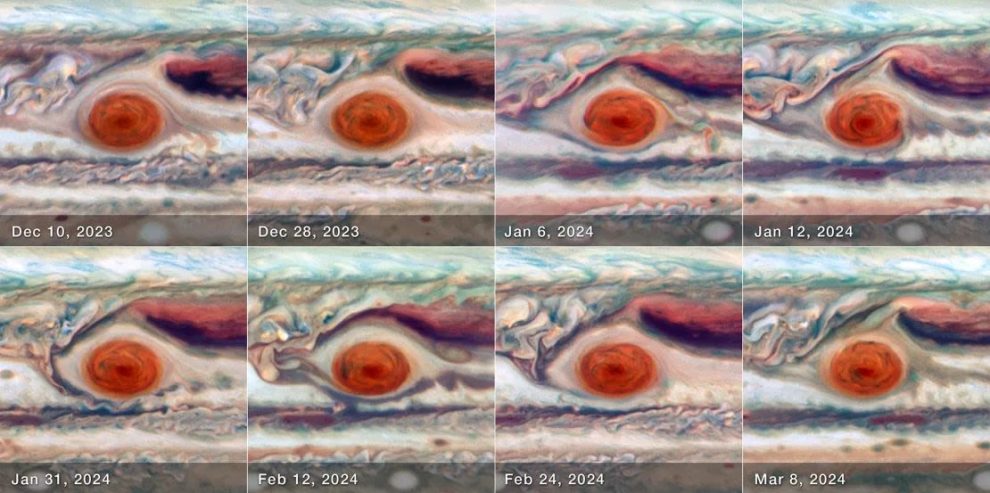() – New observations of Jupiter’s Great Red Spot captured by the Hubble Space Telescope show that the 190-year-old storm moves like jelly and changes shape like a stress ball when squeezed.
The unexpected observations, which Hubble took over 90 days from December to March, show that the Great Red Spot is not as stable as it seems, according to astronomers.
The Great Red Spot (GRS) is an anticyclone, or large circulation of winds in Jupiter’s atmosphere that revolves around a central area of high pressure along the planet’s southern mid-latitude cloud belt. And the long-lasting storm is so big — the largest in the solar system — that Earth could fit inside it.
Although storms are generally considered unstable, the Great Red Spot has persisted for nearly two centuries. However, the changes observed in the storm appear to be related to its movement and size.
A time-lapse of the images shows the vortex “wagging” like jelly and expanding and contracting over time.
The researchers described the observation in an analysis published in The Planetary Science Journal and presented on Wednesday at the 56th Annual Meeting of the Division of Planetary Sciences of the American Astronomical Society in Boise, Idaho.
“While we knew that its movement varies slightly in its length, we did not expect to see the size also fluctuate. To our knowledge, it has not been identified before,” said the study’s lead author, Amy Simon, a planetary scientist at NASA’s Goddard Space Flight Center in Greenbelt, Maryland, in a statement.
“This is really the first time we’ve had the right imaging cadence from the GRS,” Simon said. “With Hubble’s high resolution, we can say that the GRS is definitely compressing and expanding while moving faster and slower. “That was very unexpected.”
Astronomers have observed the iconic crimson feature for at least 150 years, and sometimes the observations result in surprises, including the latest revelation that the storm’s oval shape can change dimensions and appear thinner or thicker at times.
Recently, a separate team of astronomers examined the heart of the Great Red Spot using the James Webb Space Telescope to capture new details in infrared light. Hubble’s observations were made in visible and ultraviolet light.
The study, published on September 27 in the Journal of Geophysical Research: Planets, revealed that the Great Red Spot is cold at the center, causing ammonia and water to condense within the vortex and create dense clouds. The research team also detected phosphine within the storm, which could play “a role in generating those mysterious” red colors that make the Great Red Spot so iconic, said study co-author Leigh Fletcher, a science professor. planetary science at the University of Leicester in the United Kingdom, in a statement.
NASA scientists use Hubble’s keen eye to track the storm’s behavior once a year through the Outer Planet Atmospheres Legacy (OPAL) program, which Simon leads. Scientists use this program to observe the outer planets in our solar system and see how they change over time.
But the new observations were taken separately through a program dedicated to studying the Great Red Spot in more detail, looking at how the storm changed over a matter of months, rather than in a singular annual snapshot.
“To the untrained eye, Jupiter’s striped clouds and its famous red storm could appear static, stable and long-lived for many years,” Fletcher said. “However, closer inspection shows incredible variability, with chaotic weather patterns as complex as anything we have here on Earth. “Planetary scientists have struggled for years to see patterns in this variation, anything that might give us insight into the physics underlying this complex system.”
Fletcher was not involved in the new study.
Insights gained through the program’s observations of our solar system’s largest storms can help scientists understand what the climate might be like on exoplanets orbiting other stars. That knowledge can expand your understanding of weather processes beyond those we experience on Earth.
Simon’s team used Hubble’s high-resolution images to closely examine the changes in size, shape and color of the Great Red Spot.
“When we look closely, we see that a lot of things are changing from one day to the next,” Simon said.
The changes included a brightening of the storm core when the Great Red Spot is at its largest size while it oscillates.
“As it accelerates and decelerates, the GRS is pushing against windy jet streams to the north and south of it,” study co-author Mike Wong, a planetary scientist at the University of California, Berkeley, said in a statement. “It’s similar to a sandwich where the slices of bread are forced to bulge when there’s too much filling in the middle.”
On Neptune, dark spots can move around the planet since there are no strong jet streams holding them in place, Wong said, while the Great Red Spot is trapped between jet streams at a southern latitude on Jupiter.
Astronomers have noticed that the Great Red Spot is shrinking since the OPAL program began a decade ago and predict that it will continue to do so until it reaches a stable, less elongated shape, which could reduce the wobble.
“Right now it is overfilling its latitude band relative to the wind field. Once it shrinks into that band, the winds will really hold it in place,” Simon said.

The new Hubble study completes more pieces of the puzzle about the Great Red Spot, Fletcher said. Although scientists have known that the storm’s westward drift has an unexplained 90-day oscillation, the pattern of acceleration and deceleration does not appear to change even though the storm is shrinking, he added.
“By observing the GRS for a few months, Hubble has shown that the anticyclone itself is changing its shape along with this oscillation,” Fletcher said. “The change in shape is important, as it may be affecting how the edge of the vortex interacts with other passing storms. In addition to Hubble’s gorgeous images, this study shows the power of observing atmospheric systems over long periods of time. “You need that kind of monitoring to detect these patterns, and it is clear that the more you look, the more structure you see in the chaotic climate.”





![[Img #74683]](https://thelatestnews.world/wp-content/uploads/2024/12/The-main-mistakes-to-avoid-when-betting-on-electronic-sports-150x150.jpg)







![[Img #74683]](https://thelatestnews.world/wp-content/uploads/2024/12/The-main-mistakes-to-avoid-when-betting-on-electronic-sports-300x200.jpg)


Add Comment